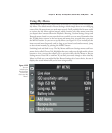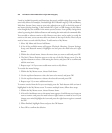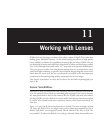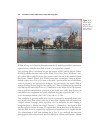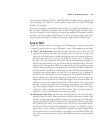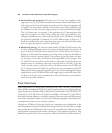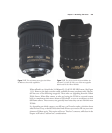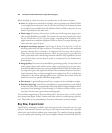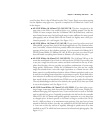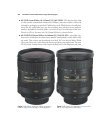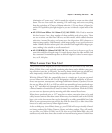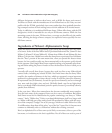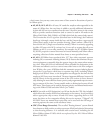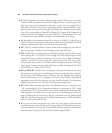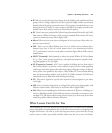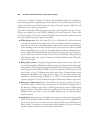your first lens. Here’s a list of Nikon’s best-bet “first” lenses. Don’t worry about sorting
out the alphabet soup right now; I provide a complete list of Nikon lens “codes” later
in the chapter.
■ AF-S DX Nikkor 18-105mm f/3.5-5.6G ED VR. This lens, introduced at the
same time as the D90, is an excellent choice as a “walking around” lens for the
D7000. It’s more compact than the 18-200mm VR II (described later), and has a
more limited zoom range. Its focal length range is quite sufficient for most general
photography, and at around $300 with the camera (or slightly more when pur-
chased separately), it’s a real bargain. (See Figure 11.3.)
■ AF-S DX Nikkor 18-55mm f/3.5-5.6G VR. If you owned an earlier entry-level
Nikon dSLR, you may have a lens in this focal length left over. The vibration reduc-
tion (“anti-shake”) feature of this lens partially offsets the relatively slow maximum
aperture of the lens at the telephoto position. It can be mated with Nikon’s AF-S
DX VR Zoom-Nikkor 55-200mm f/4-5.6G IF-ED to give you a two-lens VR pair
that will handle everything from 18mm to 200mm, at a relatively low price.
■ AF-S DX Nikkor 16-85mm f/3.5-5.6G ED VR. The 16-85mm VR lens is the
zoom that would make a lot of sense as a kit lens for the D7000. If you really want
to use just a single lens with your camera, and don’t need much in the way of tele-
photo focal lengths, this one provides an excellent combination of zoom range,
image quality, and features. Unlike the 18-200mm kit lens, this one has a zoom
range that extends from a true wide angle (equivalent to a 24mm lens on a full-
frame camera) to useful medium telephoto (about 128mm equivalent), and so can
be used for everything from architecture to portraiture to sports. If you think vibra-
tion reduction is useful only with longer telephoto lenses, you may be surprised at
how much it helps you hand-hold your D7000 even at the widest focal lengths.
The only disadvantage to this lens is its relatively slow speed (f/5.6) when you crank
it out to the telephoto end. (See Figure 11.4.)
■ AF-S DX Zoom-Nikkor 18-70mm f/3.5-4.5G IF-ED. If you don’t plan on get-
ting a longer zoom-range basic lens and can’t afford the 16-85 zoom, I highly rec-
ommend this aging, but impressive lens, if you can find one in stock or available
used at relatively low prices. Originally introduced as the kit lens for the venerable
Nikon D70, the 18-70mm zoom quickly gained a reputation as a very sharp lens
at a bargain price. It doesn’t provide a view that’s as long or as wide as the 16-85,
but it’s a half-stop faster at its maximum zoom position. You may have to hunt
around to find one of these, but they are available for $250-$300 and well worth
it. I own one to this day, and use it regularly, although it spends most of its time
installed on my D70, which has been converted to infrared-only photography. (See
Figure 11.5.)
Chapter 11 ■ Working with Lenses 351



